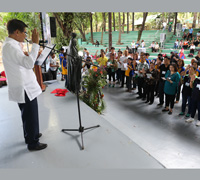Cimatu: Boracay keeps getting better one year after rehab started
Boracay keeps getting better a year after it started undergoing rehabilitation, according to Secretary Roy A. Cimatu of the Department of Environment and Natural Resources (DENR).
“Much has changed in Boracay since we started and I am happy that we are able to sustain the gains we achieved since we reopened in October last year,” Cimatu said on April 26, which is exactly one year since the resort island was closed to the public for six months to pave the way for its rehabilitation from serious environmental damage.
Cimatu, who heads the Boracay Inter-Agency Task Force (BIATF) in charge of the island’s rehabilitation, said the coliform level in Boracay waters “has significantly gone down,” based on the latest water quality monitoring done by the DENR’s Environmental Management Bureau.
The environment chief noted that the highest coliform level recorded was only 40 most probable number per 100 milliliters (mpn/100 ml). The safe level is 100 mpn/100 ml for Class SB water that is suitable for swimming, skin diving and other recreational activities.
He also reported that there had been “no algae year-round,” indicating that “it is really the dirty water which is causing what used to be a natural occurrence.”
Cimatu said the entire stretch of Boracay’s White Beach is already safe for swimming, and he was hoping the Bulabog Beach, which is now solely used for water sports, will also be declared “swimmable” soon.
So far, Cimatu said 51 establishments along the White Beach have their own sewage treatment plants (STPs) while others are now connected to the sewer line. Forty-two establishments in other areas of the island opted to have their own STPs, he added.
He said demolition orders have been served to establishments violating the 25+ 5 meter easement rule along the White Beach and Bulabog Beach, almost all of them chose to self-demolish. Those who violated the 12-meter road easement were also ordered to remove their illegal structures.
Cimatu said the construction of the Circumferential Road will continue. “Last year, it would take tourists an hour to reach their hotels because of traffic congestion. Now it would only take 20 minutes because of the paved and cleared roads,” he said.
At present, the road from Cagban Port to Hue hotel is now 95 percent finished; Hue Hotel to the Elizalde property is 95 percent done; and what is called the Missing Gap is also 95 percent completed.
Plans are also underway to make Cagban Jetty Port an all-year round port. Previously, it was only used during the Amihan or dry season from November to April as an alternate to Tagbisaan Jetty Port, which is used during Habagat or wet season from May to October.
Despite these achievements, Cimatu said more needs to be done for Boracay to ensure its sustainability as a world-class ecotourism destination.
“Although we have reopened Boracay to global tourism, the rehabilitation of Boracay is not yet complete and remains a work in progress,” he said.
“What we have accomplished thus far has earned commendations, but building sustainability requires time as well as the continuing support of the people of Boracay,” he added.
The government, through the BIATF, is commemorating the first anniversary of the much-publicized closure of Boracay with a week-long celebration promoting the conservation and sustainability.
Low-key activities were lined up for the first-ever “Sustainability Week,” which runs from April 26 to May 1.
The BIATF wanted to keep the observance of “Sustainability Week” simple and without much fanfare, unlike the infamous “Laboracay” which used to be celebrated every Labor Day weekend.
Laboracay was an annual event where beach parties were held to draw people to Boracay. Tourist arrivals tend to peak around this time.
For the Sustainability Week, the BIATF has identified activities that would distribute crowds to pocket events at different locations on the island, particularly in plazas, gyms, and other spaces.
No parties would be allowed on the beachfront. All activities are also scheduled only until 12 midnight.
The BIATF reminds those in the island to maintain cleanliness, which will be strictly monitored by enforcers from the DENR-LAWIN and the Malay-Solid Waste teams.
Tourists and guests can test their taste buds in a nightly banchetto food festival sponsored by the Boracay Foundation along Laketown Road. They can also register to avail of free rides that will ferry them from D’Mall to other event locations.
Other activities during the week-long celebration include Zumba sessions, paraw-sailing and dive festivals, Ati-atihan parade, sports competition, symposiums and mini-concerts. ###
- Details
- Parent Category: News & Events
- Category: Press Releases



